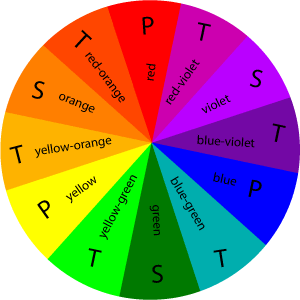The first part of colour that is normally taught at the beginning is the Colour Wheel:
 As shown here, the colour wheel has normally got 12 colours within it, and with these 12 colours can be used to make up the Primary Colours, the Secondary Colours and the Tertiary Colours.
As shown here, the colour wheel has normally got 12 colours within it, and with these 12 colours can be used to make up the Primary Colours, the Secondary Colours and the Tertiary Colours.The Primary Colours are the 3 pigment colours that cannot be formed by any combination of other colours:
Red
Blue
Yellow.
The Secondary Colours are the colours that are created when the primary colours have been mixed together:
GreenOrange
Violet.
The Tertiary Colours are the colours that are created when the primary and secondary colours are mixed together:
Red-orange
Red-violet
Blue-violet
Blue-green
Yellow-green
Yellow-orange.
As I have stated there are only 3 of the Primay colours and 3 Secondary colours however there are 6 Tertiary colours, due to as I have stated the tertiary colours are created via mixing the secondary and primary colours together, therefore creating a greater number of combinations.
Using the Colour Wheel we are also able to create colour swatches using different combinations of colours.
Complimentary: This means using 2 colours that are at opposites sides of the colour wheel, for example, Yellow and Violet.
Split Complimentary: This means using 3 colours, in a similar fashion to Complimentary, however there would be one colour on one side and then 2 colours from the compliment, for example Green, Red-orange and Red-violet.
Analogous: This means that 3 colours that sit next to each other on the colour wheel are using harmoniously, for example, Yellow-green, Green and Blue-green.
Monochromatic: This means that you would use one colour, however you would then using different shades of that one colour.
Achromatic: This means that there are no colours only using neutral shades/tones, for example Black and White.

No comments:
Post a Comment